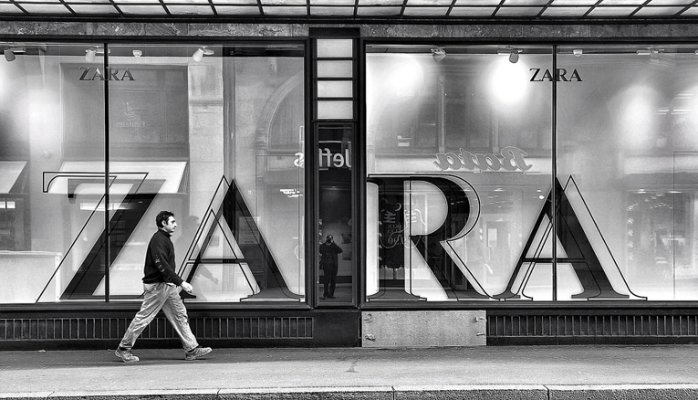If we were to pick and adjective to describe how Zara operates, the best one would be “fast”.
Taking a look at most clothing brands production process, we observe a consistent pattern that happens every year: they produce two collections (a spring/summer and a fall/winter collection). What this implies is that a huge amount of time and resources is put all at once long before the actual time of consumption in order to compete in the market (Guercini 2001).
When it comes to fashion, where the ability to generate high sales revenues is extremely unpredictable because the success of a collection depends on uncertain trends, this strategy can involve a great amount of risk. To minimize that risk, firms typically invest a lot of time and resources in attempting to predict what the next trends will be.
This is where Zara’s approach differs and succeeds at greatly decreasing the risk. Zara designs, produces, distributes and sells its collection in only four weeks, instead of the six to twelve months that its competitors take to do the exact same thing. This model also updates two new designs every week, creating a new concept of continuous collection which lowers stock levels. Overstock is one of the most pressing problems of the fashion industry, leading to high markdowns and lost value (BCG Pulse of the Fashion Industry Report 2017)
This Zara’s innovative approach brings along several financial benefits:(1) Decrease in storage costs and markdowns: the continuous collection concept decreases the amount of stock stores receive each time, which not only greatly decreases storage costs but only eliminates costs associated to stock drain; (2) Increase the frequency customer visit stores: customers have incentives to visit stores more often because new items arrive in store every week; (3) Increase the buying stimulus: since stock changes throughout the season, customers have more incentives to buy today instead of tomorrow due to limited stock (Bruce & Daly 2006). All of these benefits result in a great cost reduction and revenue increase.
The Zara business model that is outperforming the competition has more interesting features.
In the fashion industry, almost every clothing brand uses a top-down approach when they are developing their products, that is, the collection items are designed, modified and chosen by a restricted number of people who have a speculative role on what will be trendy. Later, consumers choose from that the options provided in stock.
However, consumers have become more demanding, more discerning, and less predictable in their purchasing behavior (The State of Fashion McKinsey Report 2016). In response to that, Zara designed a more efficient approach. In a nutshell, what they do is collecting information about consumers preferences right from the source. For example, scouts go onto the streets and in the malls of cities to see what people are wearing; and store managers take note on what customer tastes are like, which they later report back to headquarters.
Besides that, they also collect vital data information such as daily sales numbers, which allow designers to approximate what types of fashion are selling well. Zara’s information system basically allows designers to have access to real-time and meaningful information related to what type of fabrics to use, what type of cuts, which colours, among many other aspects. This allows them to finish products only when you have accurate information on customer preferences (Lee, 2004).
Developing a comprehensive retailing business model means transforming the supply-chain system and using digital technology to capture a broad picture of true customer needs and to communicate directly with individual customers (Fast Retailing Annual Report 2016).
What is more, the information technology used by Zara has shortened the time it takes to go from design conception to the time of arrival at stores’ racks (which in some cases can take only 3 weeks).
To sum up, this bottom-up approach means designs are created based on instant feedback and tailored according to regional preferences. Therefore, this strategy has allowed the retailer to become popular worldwide and cater directly several very specific niches.
References:
Guercini S. (2001) ‘Relation between branding and growth of the firm in new quick fashion formulas: analysis of an Italian case’, available at http://www.emeraldinsight.com/doi/pdfplus/10.1108/EUM0000000007280
Boston Consulting Group (2017) ‘Pulse of the Fashion Industry Report’, available at https://www.copenhagenfashionsummit.com/wp-content/uploads/2017/05/Pulse-of-the-Fashion-Industry_2017.pdf
Bruce and Daly (2006) ‘Buyer behaviour for fast fashion’, available at http://www.emeraldinsight.com/doi/full/10.1108/13612020610679303
McKinsey (2016) ‘The State of Fashion’ available at https://www.mckinsey.com/industries/retail/our-insights/the-state-of-fashion
Lee, H. (2004) ‘The Triple-A Supply Chain’ available at http://www.scap.pk/article/SupplyChaindd.pdf
Fast Retailing (2016) ‘Fast Retailing Annual Report’ available at https://www.fastretailing.com/eng/ir/library/pdf/ar2016_en.pdf

